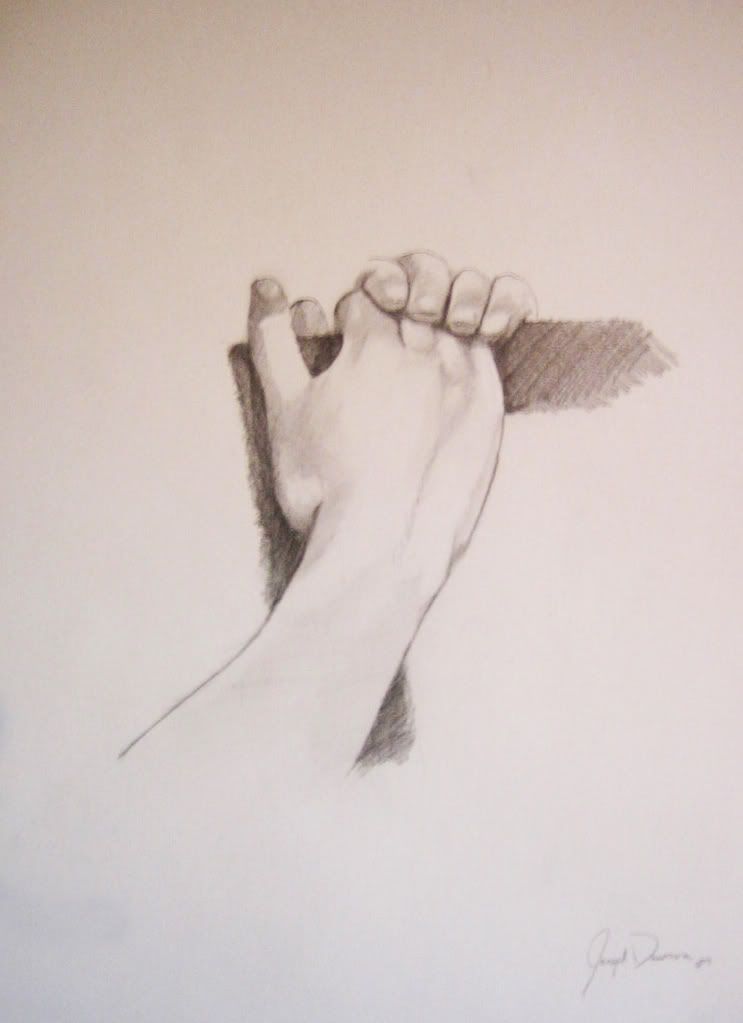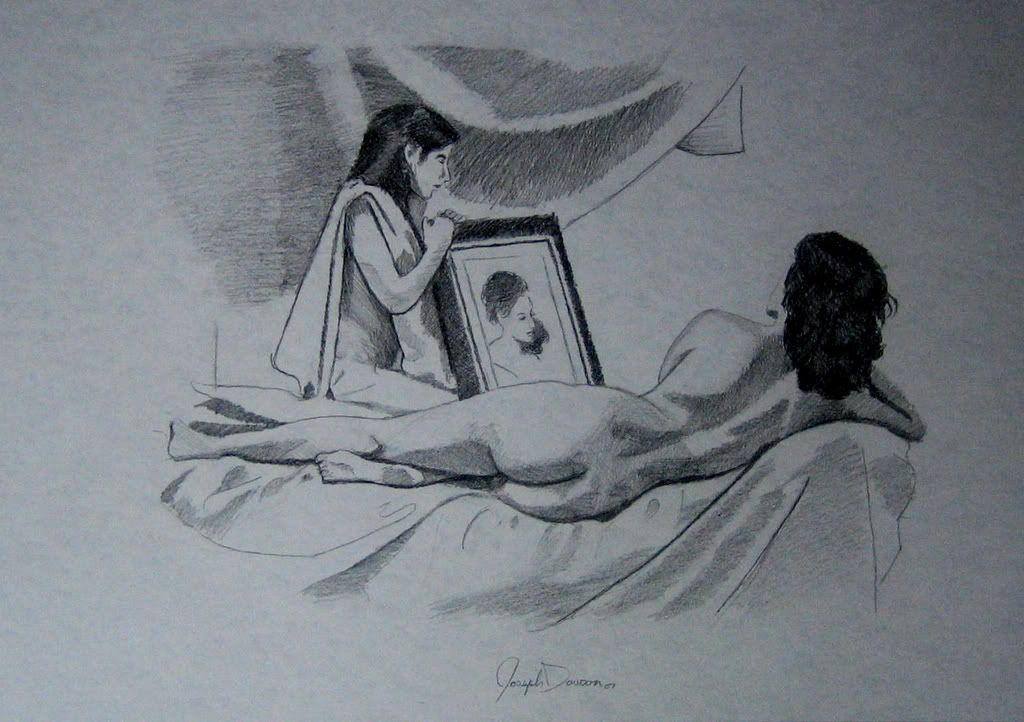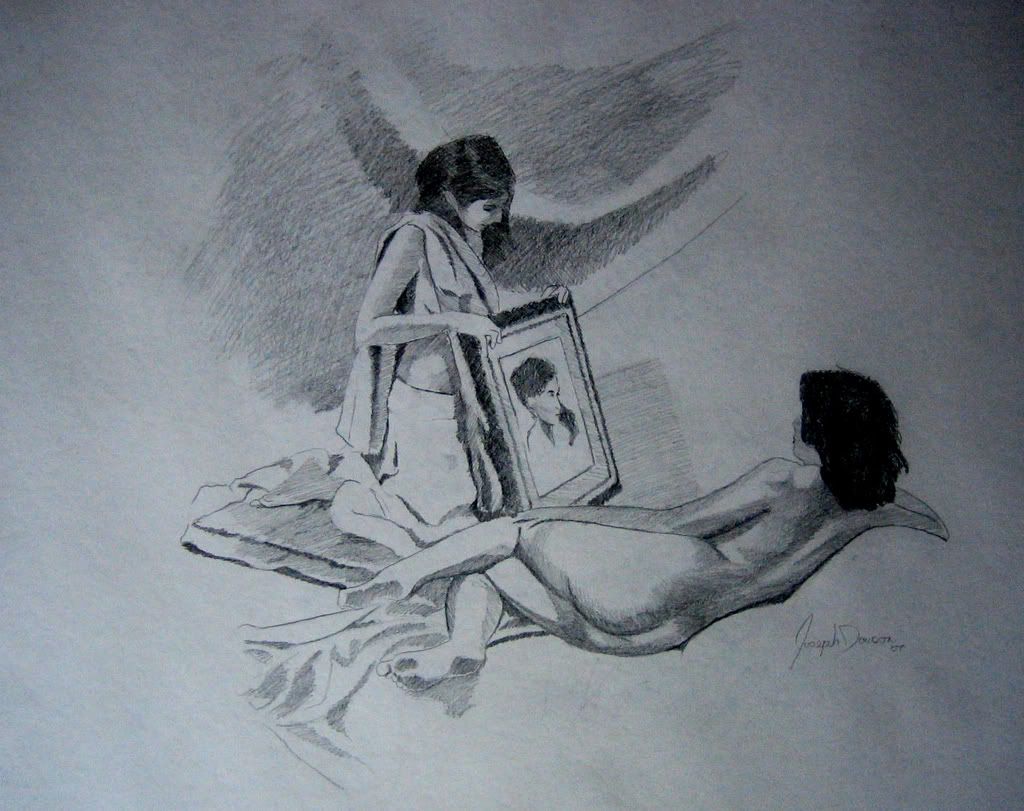Saturday, November 17, 2007
On The Portrait
For my part I wanted a faithful portrait of the woman as well, yet I did not wish to make the same concessions that Velasquez had. To this end I have decided to abandon the mirror concept altogether and in its place have the lady in attendance holding a painting of my Venus. Now, this presents two very interesting challenges.
Firstly, it is usually the artists endeavour to try and create the illusion of a three dimensional quality on a two dimensional surface and so we work with tone, light, values and colours in order to achieve our effects. It is an entirely different thing to paint a painting in a painting and have it look like a three dimensional form locked onto a two dimensional surface. In a sense I am trying to make the internal portrait less real than the reality of the Venus contemplating it.
The next and perhaps most daunting task is to make the image conform to a second perspective. Not only do I have to do a portrait, but a portrait (with its own set of perspectives) conforming to an environment involved in its own set of vanishing points.
Sounds like fun, doesn’t it?
On a personal note, I find this more challenging than just painting the reverse of my Venus’s face. So, with brush and paint to hand, once more into the breach!
My previous post included drawings what I thought might look nice as a portrait. Again, drawing is where all the problems and possibilities have their say. I always find it interesting when the time arrives to actually throw it on the canvas to see how it fares!
Thursday, November 15, 2007
The Attendant




Monday, November 5, 2007
Friday, November 2, 2007
The Composition

This second picture works well enough. The “Venus” is more prominent and the frame a greater interest to the eye. The lady holding the frame is not as interesting visually as she is in the previous image but for all intents and purposes, she will do. The only problem now was that I had accomplished an even greater departure from the Velasquez painting and now had to ask myself some very serious questions. Did I want to paint this image? I was still not entirely convinced about the position of the nude. There is more loveliness and sensuality in Velasquez’s nude. Is the bird’s eye view appropriate? Perhaps I should frame the composition a little lower; something more in line with the original composition.

Of course, these drawings are by no means the last word on image making and many a change can happen between pencil and paint brush! I have yet to do studies for the specifics such as the hands, feet or head but I do have enough information to draw and flesh out most of what I intend to do on the canvas. The canvas I am using is fine linen (cotton can lose its shape over time so I tend to avoid it when I want to do a major work). My next update will include a short video clip of the beginning of the canvas.
Friday, October 19, 2007
Venus at the National Gallery, London
 Well here I am in the National Gallery in
Well here I am in the National Gallery in I had a difficult enough time trying to get a picture of the painting with my model as the anti-camera police were in full force. I had managed to get about six pictures, all of them with a very nervous Spanish model smiling hesitatingly whilst the Gallery’s staff intoned with profound gravity and seriousness “no cameras, no pictures”! By the end, it was all very cloak and dagger, I with my camera, she with her embarrassment as I whispered, “go and stand beside it now, they’re not looking” and they with their sudden appearances and no small amount of frowning and censuring. Yet, here is the picture and a few close ups for my own look at how Velasquez handled the brushwork.
It’s a fantastic painting to see in life. It is far more impressive by far to see it to scale than it is in reproduction. There’s a lot to be said for how the size of a canvas can contribute to the overall effect of an image. They have it framed behind non-reflective glass now and given its history, it’s easy enough to see why. I will post the article regarding its 1914 attack at a later date.
My model, who is herself from
So, back to
Thanks for reading!
Monday, October 8, 2007
About the Velasquez Venus Project

Welcome all to the first update of what I hope will be many.
For those of you who know me and my work, it may not surprise you to learn that I have recently got it into my head to paint my own “Venus with a Mirror” or what is more popularly known as Velasquez’s “Rokeby Venus”. Why this painting? I suppose it has been a fascination of mine for a long time now. I remember looking at it many years ago and thinking how absolutely beautiful the woman was. She seemed set apart from any woman I had ever seen in life. I was essentially captivated by the painting. I believe it can be safely said that by looking at the woman in this painting I had experienced my first intimation of the existence of what is more popularly known as the muse.
Gabriel Garcia Marquez probably summed it up best when he wrote:
“That night I discovered the improbable pleasure of contemplating the body of a sleeping woman without the urgencies of desire or the obstacles of modesty.”
I suppose the lasting impression this painting made in part explains why I paint women or the idea of women.
I shall do my best. I hope to include an on going blog detailing the progress of the painting. I hope to include a few video feeds as well as preliminary sketches and notes. I hope everything runs smoothly enough. Cross your fingers!
Just to say, Velasquez was from
A point of interest regarding the history of the painting is that it was mutilated in 1906 by the Suffragist Mary Richardson in protest for the wrongs done to a Mrs. Pankhurst.

